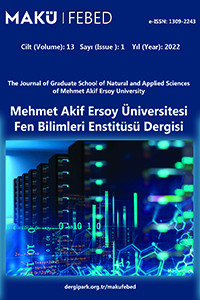CBS ve Frekans Oranı Yöntemi Kullanılarak Isparta-Burdur Dağ Yolu Heyelan Duyarlılığının Değerlendirilmesi
CBS, Frekans oranı, Heyelan, Duyarlılık haritası, Isparta, Burdur
Landslide Evaluation of Isparta-Burdur Mountain Road by Using GIS and Frequency Ratio Method
GIS, Landslide, Frequency ratio, Sensitivity map, Isparta, Burdur,
___
- AFAD (2015). Bütünleşik Tehlike Haritalarının Hazırlanması Heyelan-Kaya Düşmesi Temel Kılavuzu. Afet ve Acil Durum Yönetimi Başkanlığı, 151 s., Ankara.
- Baeza, C., Corominas, J. (2001), Assessment of shallow landslides susceptibility by means of multivariate statistical techniques. Earth Surface Processes & Landforms 26, 251-1263.
- Cruden, D.M., Varnes, D.J. (1996). Landslide Types ve Processes. Landslides Investigation ve Mitigation. Special Report 247. In: Turner, A.K. ve Schuster, R.L. (eds.), 36–75 pp.
- Dai, F.C., Lee, C.F., Li, J., Xu, Z.W. (2001). Assessment of landslide susceptibility on the natural terrain of Lantau Island. Hong Kong. Environmental Geology 43 (3): 381–391.
- Dai, F.C., Lee, C.F. (2002). Landslide characteristics and, slope instability modeling using GIS. Lantau Island, Hong Kong, Geomorphology 42(3-4), 213-228.
- Fell, R., Corominas, J., Bonnard, CH., Cascini, C., Leroi, E., Z. Savage, W. (2008). Guidelines for landslide susceptibility hazard ve risk zoning for land use planning. Engineering Geology 102, 99–111.
- Guzzetti, F., Carrara, A., Cardinali, M., Reichenbach, P. (1999). Landslide hazard evaluation: a review of current techniques ve their application in a multi-scale study. Central Italy. Geomorphology 31, 181–216.
- Guzzetti, F., Reichenbach, P., Cardinali, M., Galli, M., Ardizzone, F. (2005). Probabilistic landslide hazard assessment at the basin scale. Geomorphology 72, 272–299.
- Guzzetti, F., Reichenbach, P., Ardizzone, F., Cardinali, M., Galli, M. (2006). Estimating quality of landslide susceptibility models. Geomorphology 81, 166–184.
- Hasekioğulları, G. D., Ercanoğlu, M. (2012). A new approach to use AHP in landslide susceptibility mapping: a case study at Yenice (Karabuk, NW Turkey). Natural Hazards 63, 1157-1179.
- Kavzoglu, T., Şahin, E.K., Çölkesen, İ. (2012). Heyelan Duyarlılığının İncelenmesinde Regresyon Ağaçlarının Kullanımı: Trabzon Örneği. Harita Dergisi 147(3), 21-33.
- Kanungo, D.P., Arora, M.K., Sarkar, S., Gupta, R.P. (2009). A fuzzy set based approach for integration of thematic maps for landslide susceptibility zonation. Georisk Vol. 3, Issue 1, 30-43 p.
- Kayastha, P., Dhital, M.R., De Smedt F. (2013). Application of the analytical hierarchy process (AHP) for landslide susceptibility mapping: A case study from the Tinau watershed, west Nepal. Computers & Geosciences 52, 398-408.
- Komac, M. (2006). A landslide susceptibility model using the Analytical Hierarchy Process method ve multivariate statistics in perialpine Slovenia. Geomorphology 74, 17-28.
- Lee, S., Talib, J.A. (2005). Probabilistic landslide susceptibility ve factor effect analysis. Environmental Geology 47: 982-990.
- Lee, S., Ryu,J.-H., Kim, I.-S. (2007). Landslide susceptibility analysis ve its verification using likelihood ratio, logistic regression, ve artificial neural network models: case study of Youngin. Korea. Landslides 4, 327-338.
- MGM (2018). Orman ve Su İşleri Bakanlığı, Meteoroloji Genel Müdürlüğü, Haber Bülteni, Ocak-2018, https://www.mgm.gov.tr/FILES/resmi-istatistikler/2018-ocak-iklimVerileriHaberBulteni.pdf (Erişim tarihi; 15 Şubat 2018)
- Moradi, M., Bazyar, M.H., Mohammadi, Z. (2012). GIS Based Landslide susceptibility mapping by AHP method, a case study, Dena City, Iran. Journal of Basic ve Applied Scientific Research 2(7), 6715-6723.
- Moreiras, M. S. (2005). Landslide susceptibility zonation in the Rio Mendoza Valley, Argentina. Geomorphology 66, 345–357.
- Özşahin, E. (2015). Coğrafi Bilgi Sistemleri yardımıyla heyelan duyarlılık analizi: Ganos Dağı Örneği (Tekirdağ). Harita Teknolojileri Elektronik Dergisi 7(1): 47-63.
- Pachauri, A.K., Pant, M. (1992). Landslide hazard mapping based on geological attributes. Engineering Geology 32, 81–100.
- Pradhan, B. (2010). Landslide Susceptibility mapping of a catchment area using frequency ratio, fuzzy logic ve multivariate logistic regression approaches. Journal of the Indian Society of Remote Sensing 38 (2) 301-320.
- Pradhan, B., Lee, S. (2010). Landslide susceptibility assessment ve factor effect analysis: backpropagation artificial neural networks ve their comparison with frequency ratio ve bivariate logistic regression modelling. Environmental Modelling & Software 25, 747-759.
- Yalçın, A. (2008). GIS-based landslide susceptibility mapping using analytical hierarchy process ve bivariate statistics in Ardesen (Turkey). Catena 72, 1-12.
- Liu, Z., Nadim, F., Garcia-Aristizabal, A., Mignan, A., Fleming, K., Luna, B. Q. (2015). A three-level framework for multi-risk assessment. Georisk 9, 2, pp. 59-74.
- Yayın Aralığı: Yılda 2 Sayı
- Başlangıç: 2010
- Yayıncı: Burdur Mehmet Akif Ersoy Üniversitesi
Üst Yaklaşım Sayılarının Öncül Komşuluklarla Elde Edilmesi
Sadık BAYHAN, Nazlı Tuğçe BAYTAROĞLU
Yüzeysel Zemin İyileştirmesinde Yeni Bir Malzeme Olarak Atık Gazbeton Kullanımı
Akademik Ofislerin Verimlilik Üzerine Değerlendirilmesi: Mehmet Akif Ersoy Üniversitesi Örneği
Duygu KURTOĞLU, M. Rafet KISTIR
Anadolu’nun Tarihi Yolları ve Ankara için Bir Yeşil Yol Planlama Olanağı
Drosophila’da Aspartam Tarafından Oluşturulan Mitokondrial DNA Hasarı
NaOH ile Modifiye Edilmiş Kızılçam (Pinus brutia Ten.) Yongalarının Levha Üretimindeki Performansı
Kerem HEPDENİZ, İbrahim İskender SOYASLAN
Mahmut DOĞANTÜRK, Mustafa Emre GÜRLEK
Ozan GÜLDİREN, Selda TEKİN ÖZAN
Farklı Gıdalardan İzole Edilen Laktik Asit Bakterileri’nin Antibiyotik Direnç Profilleri
